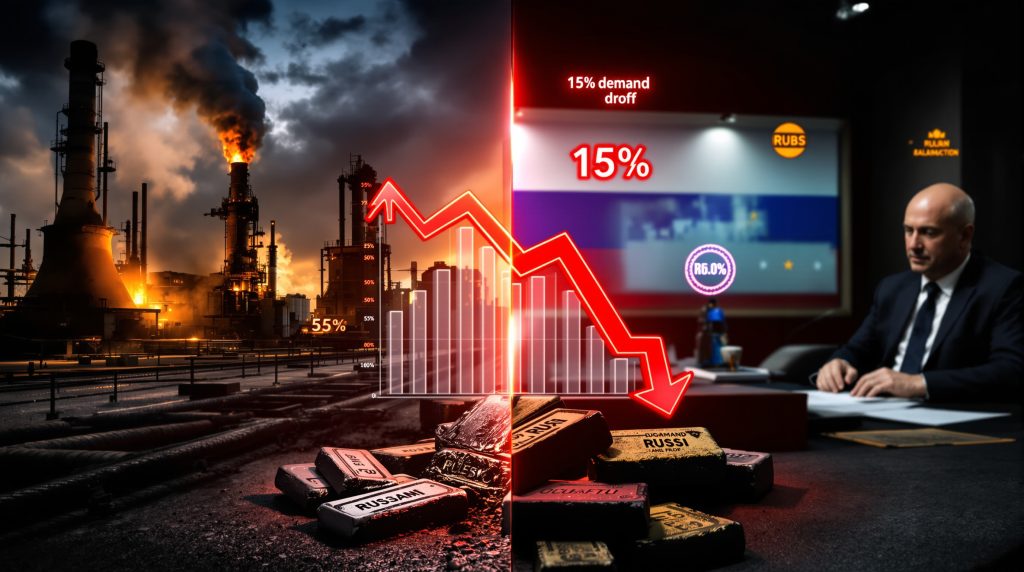Russia Considers Bankruptcy Moratorium for Metals Industry: Economic Implications and Impact
Russia is considering implementing a moratorium on bankruptcies in its metals industry, a sector currently facing multiple challenges including reduced demand, high interest rates, and a strong ruble. This potential government intervention precedents highlights growing concerns about the stability of an industry that serves as a strategic component of Russia's industrial base.
How Is Russia's Metals Industry Currently Performing?
Current Market Challenges
Russia's metals sector has entered a difficult period marked by significant demand reduction. Steel consumption has reportedly fallen by approximately 15% in the first half of the year, creating challenging conditions for producers across the country.
As the world's fifth-largest steel producer with an output of approximately 71 million tons annually, Russia's metals industry represents a substantial portion of the country's industrial base and export potential.
High interest rates implemented by the Russian central bank have restricted investment and operational flexibility for metals companies. Combined with a strong ruble and declining demand, these factors have created particularly difficult conditions for the industry.
Leading Russian steelmaker Severstal reported a 55% drop in net profit during the second quarter, demonstrating the tangible impact of these challenging market conditions on major industry players.
Economic Context Driving the Crisis
Russia's broader economic growth is projected to slow dramatically to 1.2% this year, down from 4.3% in the previous year. This economic deceleration is placing additional pressure on industrial sectors, including metals production.
The central bank's high interest rate policy, while aimed at controlling inflation, has had the side effect of restricting investment and increasing debt servicing costs for metals producers.
International sanctions continue to limit export opportunities for Russian metals companies, forcing them to reconfigure supply chains and seek alternative markets amid global economic pressures.
The strong ruble has further complicated the situation by making Russian exports less price-competitive in global markets, adding another layer of difficulty for export-oriented metals producers.
What Would a Metals Industry Bankruptcy Moratorium Entail?
Proposed Government Intervention
According to government documents, the financial stability commission met in late August to discuss support measures for the struggling sector. The document directed the economy and industry ministries to present proposals by late October on the feasibility of implementing a bankruptcy moratorium.
Such a moratorium would effectively ban creditor-initiated bankruptcy proceedings against metals companies for a specified period. This would provide breathing room for debt restructuring and operational adjustments without the immediate threat of liquidation.
This protective measure is designed to prevent precipitous failures within a sector considered strategically important to Russia's economic security and industrial self-sufficiency.
The timing of the proposals suggests an increasing urgency to address the industry's challenges before they potentially cascade into broader economic impacts.
Precedents in Other Industries
Similar protective measures were recently implemented for Russia's struggling coal industry, indicating an established pattern of government intervention in strategically important sectors facing financial distress.
The coal industry support package reportedly included tax deferrals and restrictions on dividend payments and executive bonuses, providing a potential template for metals industry assistance.
Russia has also previously implemented nationwide bankruptcy moratoriums during broader economic crisis periods, demonstrating its willingness to use this policy tool when deemed necessary, according to The Moscow Times.
These temporary measures aim to prevent cascading failures across interconnected industrial sectors while providing time for more sustainable restructuring.
Why Is the Russian Government Considering This Measure?
Warning Signs of Industry Distress
Government research has indicated an alarming trend: the share of enterprises with risky debt levels reportedly doubled last year, signaling increased vulnerability across industrial sectors.
A think-tank report released earlier this year warned of potential widespread corporate bankruptcies, highlighting the metals sector as particularly vulnerable to financial distress.
The metals sector's status as strategically important for Russia's industrial self-sufficiency makes its stability a matter of national economic security.
Protecting major employers in single-industry towns, many of which are centered around metals production, represents a significant social stability priority for Russian authorities.
Strategic Economic Importance
The metals industry represents a significant portion of Russia's industrial base and contributes substantially to the country's export earnings despite recent challenges.
Major metals companies are key employers in many regions, particularly in cities and towns built around mining and metallurgical activities where few alternative employment opportunities exist.
The sector is essential for domestic manufacturing, defense industries, and construction sectors, making its continued operation critical to broader economic functionality.
Despite sanctions and trade restrictions, metals exports remain an important source of foreign currency for Russia, further enhancing the sector's strategic importance.
How Might Interest Rate Changes Impact the Situation?
Anticipated Monetary Policy Shifts
The Russian central bank is expected to implement significant interest rate cuts in the near term, potentially reducing rates by 200 basis points according to analyst projections.
This anticipated move comes as inflation appears to be receding while economic growth is slowing faster than expected, creating conditions that favor monetary easing.
Lower interest rates would reduce borrowing costs for debt-laden metals companies, potentially providing significant financial relief.
This monetary policy shift could work in tandem with the proposed bankruptcy moratorium to create a more comprehensive support framework for struggling producers.
Industry Response to Rate Changes
A substantial rate reduction would immediately lower debt servicing costs for highly leveraged companies, improving cash flow and operational flexibility.
Companies could potentially use improved borrowing conditions to refinance existing debt at more favorable terms, restructuring their financial obligations for longer-term sustainability.
Lower financing costs might make investments in efficiency improvements and modernization more feasible, helping companies adapt to changing market conditions as part of broader mining industry evolution.
However, industry analysts suggest that rate cuts alone may be insufficient without the additional protection of a bankruptcy moratorium, particularly for companies already in severe financial distress.
What Broader Economic Factors Are Affecting Russian Metals Companies?
Global Market Conditions
International steel and metals prices have remained depressed through much of the year, placing pressure on producer margins regardless of location.
Global overcapacity, particularly from Chinese producers, continues to create challenging market conditions for metals producers worldwide, including Russian companies.
Shifting global supply chains following sanctions and trade restrictions have disrupted traditional export markets for Russian producers, forcing complex and often costly adjustments.
The ongoing energy transition is changing demand patterns for various metals and alloys, creating both challenges and opportunities that require strategic adaptation.
Domestic Economic Challenges
Construction activity in Russia has reportedly slowed significantly, reducing one of the primary sources of domestic steel demand.
Manufacturing sector contraction has further limited metals consumption, creating a challenging domestic market environment alongside export difficulties.
Russian producers face relatively high production costs compared to some international competitors, particularly in energy-intensive processes, affecting their global competitiveness.
Limited access to advanced technology due to sanctions impacts operational efficiency and innovation capacity, creating longer-term competitive disadvantages for Russian metals companies.
How Would a Bankruptcy Moratorium Affect Different Stakeholders?
Impact on Metals Companies
A moratorium would provide valuable time for companies to restructure operations and debt without immediate creditor pressure, potentially preventing precipitous failures.
This breathing space would allow for strategic repositioning in response to changing market conditions, including potential diversification or specialization strategies.
The measure would prevent fire sales of valuable assets during distressed market conditions, preserving long-term value for companies capable of eventual recovery.
Operational continuity would be maintained, preserving technical expertise, production capabilities, and workforce cohesion during the restructuring period.
Impact on Creditors and Investors
The moratorium would restrict creditors' ability to recover funds through bankruptcy proceedings for its duration, potentially creating financial pressures for lenders with significant exposure to the sector.
This intervention may create uncertainty regarding the timeline for debt resolution, potentially affecting market valuations and investment decisions.
Financial institutions might become more hesitant to extend new credit to the sector during the moratorium period, creating potential liquidity challenges.
Critics note the potential for moral hazard if poorly performing companies are shielded from market forces for extended periods without implementing necessary operational changes.
Impact on Workers and Communities
The moratorium would protect jobs in the short term by preventing immediate company closures, providing critical economic stability for workers and their families.
Communities dependent on metals industry employment would benefit from continued economic activity, preserving local business ecosystems and tax bases.
Local governments in mining and metallurgical regions would maintain their tax revenue streams, enabling the continuation of essential public services.
The breathing space provided by the moratorium could allow for potential economic diversification initiatives in heavily dependent regions, reducing long-term vulnerability to industry cycles.
What Additional Support Measures Might Accompany a Bankruptcy Moratorium?
Potential Complementary Policies
Tax deferrals or temporary reductions could provide additional financial relief for struggling metals companies, improving cash flow during the restructuring period.
Restrictions on dividend payments might be implemented to preserve cash for operations and debt servicing, ensuring company resources are directed toward sustainability.
Limitations on executive compensation and bonuses during the crisis period could be implemented, similar to measures reportedly used in the coal industry support package.
Government-backed loans or loan guarantees could ensure continued operations and liquidity during the restructuring period, particularly for companies with viable long-term business models.
Industry Restructuring Possibilities
The crisis may accelerate industry consolidation trends through mergers of struggling companies, creating stronger entities with improved economies of scale and operational efficiencies.
Strategic partnerships between companies could emerge to optimize production capacities and reduce overlapping costs in a challenging market environment.
Modernization initiatives to improve efficiency and reduce environmental impacts might be prioritized as part of restructuring plans, potentially supported by government incentives.
Development of new product lines and value-added capabilities could help diversify revenue streams away from commoditized products facing the most severe price pressures.
How Does This Compare to International Approaches?
Global Precedents for Industry Intervention
Other countries have implemented similar protective measures during industry crises, particularly in sectors considered strategically important for national economic security.
Temporary bankruptcy protections are often used alongside broader industrial policy interventions, including targeted financial support, regulatory adjustments, and trade measures.
Government intervention in strategically important sectors during periods of severe market disruption is relatively common globally, though approaches vary significantly.
The scale and scope of Russia's proposed intervention appears significant by international standards, reflecting the critical importance of the metals sector to its economy.
Balancing Market Forces and Strategic Interests
The intervention represents a calculated trade-off between market discipline and strategic economic priorities, with authorities determining that the sector's importance justifies temporary market distortion.
Long-term competitiveness ultimately requires a return to market-based operations, making the moratorium's temporary nature an important aspect of its design.
The protective period can provide space for necessary restructuring that might be impossible under immediate bankruptcy pressure, potentially resulting in more sustainable outcomes.
Success will largely depend on whether companies use the moratorium period for meaningful operational improvements rather than simply delaying inevitable market adjustments.
What Are the Long-Term Implications for Russia's Metals Industry?
Industry Transformation Outlook
The current crisis will likely accelerate consolidation within the Russian metals sector, resulting in fewer but potentially stronger companies with improved resilience to market volatility.
Companies that navigate the restructuring period successfully will likely emerge more efficient and strategically focused, though the sector as a whole may contract.
A stronger domestic market focus may develop as export opportunities remain challenging, potentially changing product mix and investment priorities.
Innovation and diversification will be essential for long-term sustainability, particularly in developing higher-value products less vulnerable to tariff-driven market impacts.
Strategic Positioning in Global Markets
Russian metals companies may need to reorient toward new export markets, particularly in regions less affected by sanctions and trade restrictions.
Value-added products could become increasingly important as basic commodities face continued price pressure from global overcapacity and competition.
Integration with supply chains in friendly nations offers potential growth opportunities, creating new strategic partnerships and market access channels.
Developing technological self-sufficiency will be crucial given continued sanctions, requiring significant investment in research, development, and domestic equipment manufacturing.
FAQ: Russia's Metals Industry Bankruptcy Moratorium
What is causing the current crisis in Russia's metals industry?
The industry faces multiple simultaneous challenges including a reported 15% drop in steel demand, high interest rates that increase debt servicing costs, a strong ruble making exports less competitive, and overall economic growth slowing to 1.2% from 4.3% last year.
When will the government decide on implementing the bankruptcy moratorium?
According to government documents, the economy and industry ministries must present proposals by late October following the financial stability commission meeting held in late August.
How has Severstal been affected by the current market conditions?
Severstal reported a 55% decline in net profit during the second quarter, primarily due to low steel prices and reduced demand resulting from high interest rates.
What other industries has Russia protected with similar measures?
The coal industry recently received support including tax deferrals and restrictions on dividend payments and executive bonuses, providing a potential template for the metals sector intervention.
What is Russia's position in global steel production?
Russia is the world's fifth-largest steel producer with an output of approximately 71 million tons annually, making it a significant player in global metals markets.
How might the expected interest rate cut affect metals companies?
The anticipated substantial rate cut could reduce debt servicing costs, potentially allowing companies to refinance existing debt at more favorable terms and invest in necessary efficiency improvements and operational adjustments.
Want To Discover The Next Major Mineral Opportunity Before The Market?
Stay ahead of ASX mineral discoveries with real-time alerts from Discovery Alert's proprietary Discovery IQ model, turning complex data into actionable investment insights. Explore why historic discoveries generate substantial returns by visiting our dedicated discoveries page and begin your 30-day free trial today.




